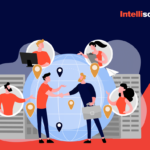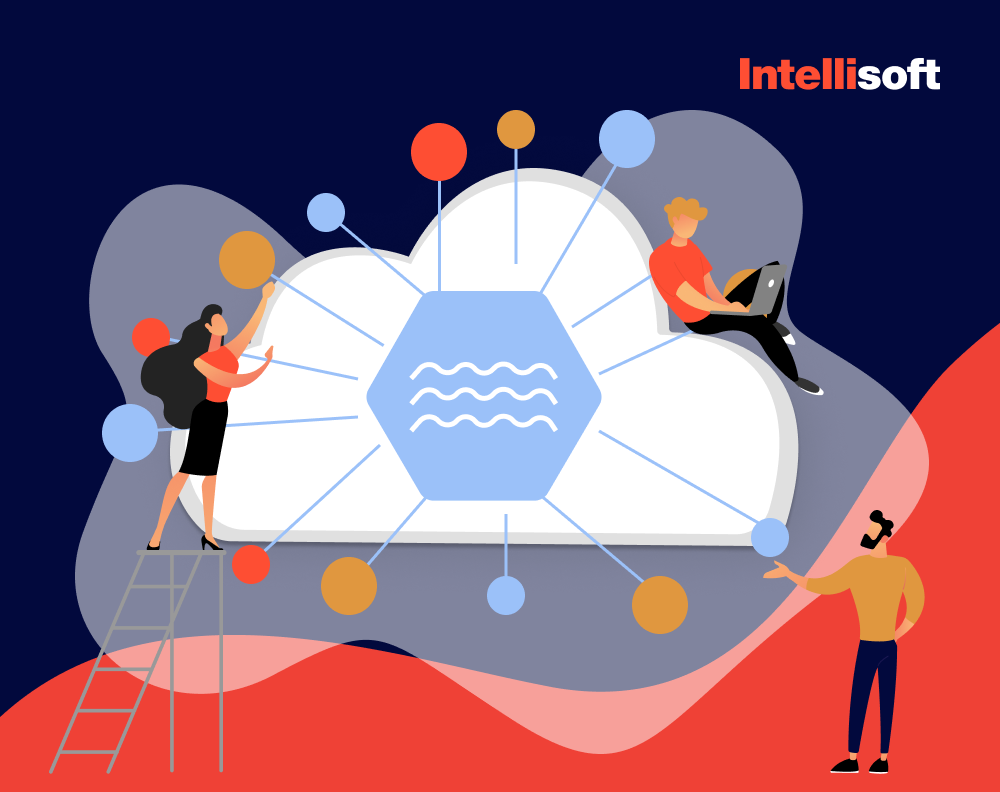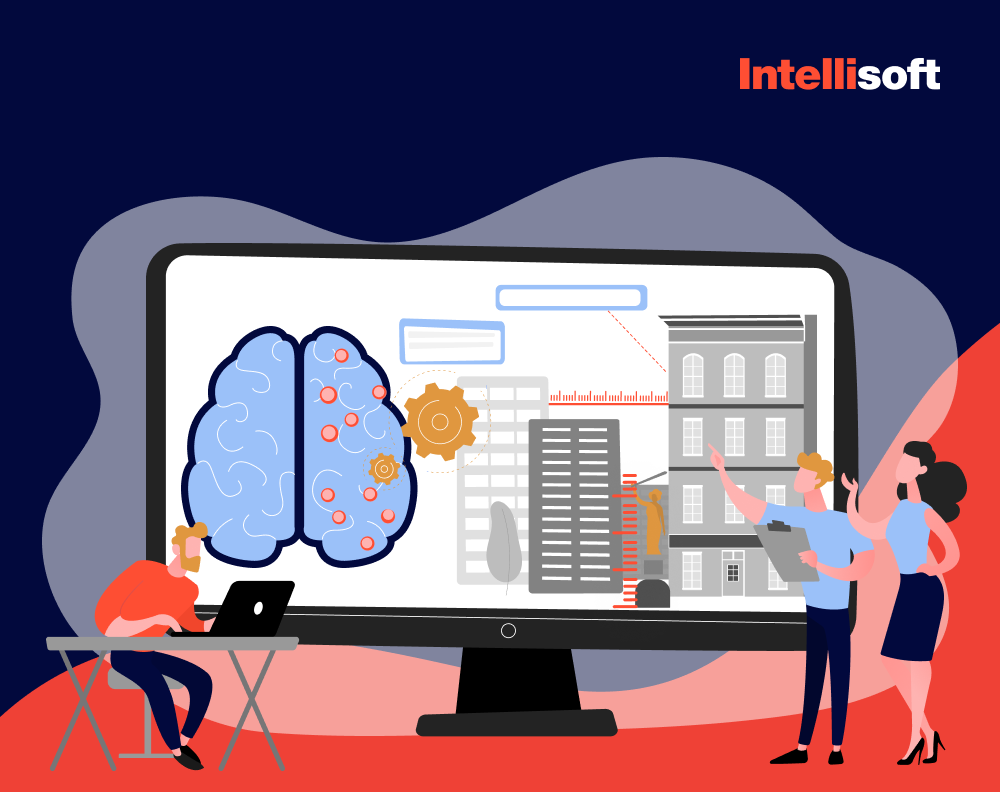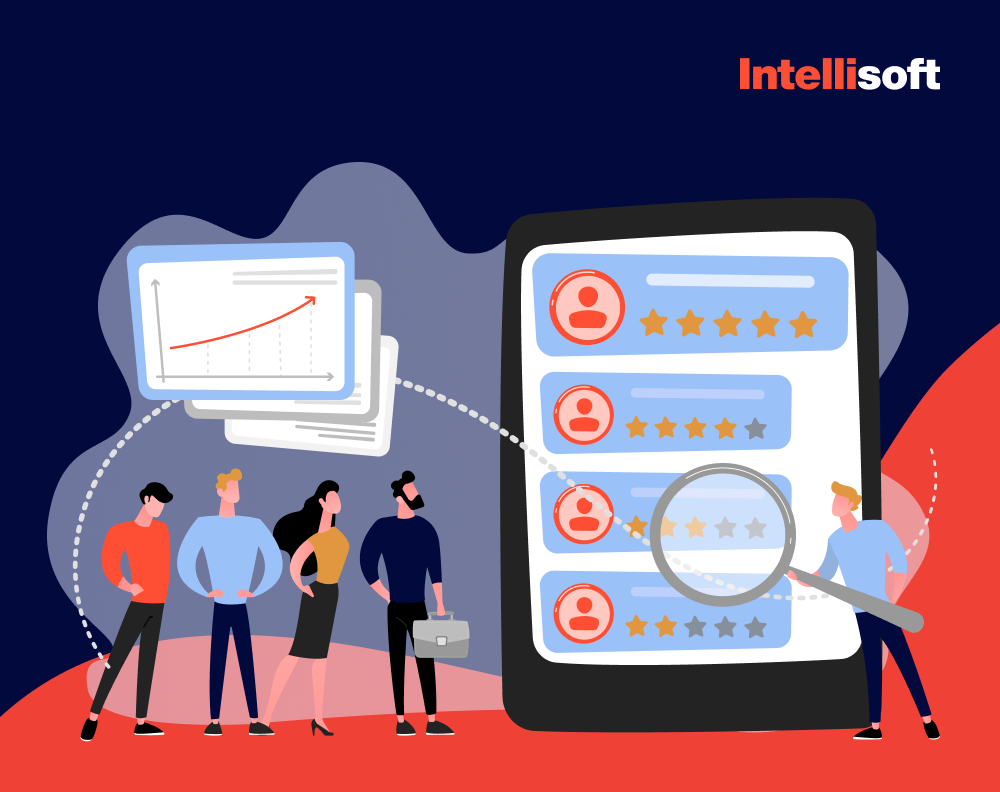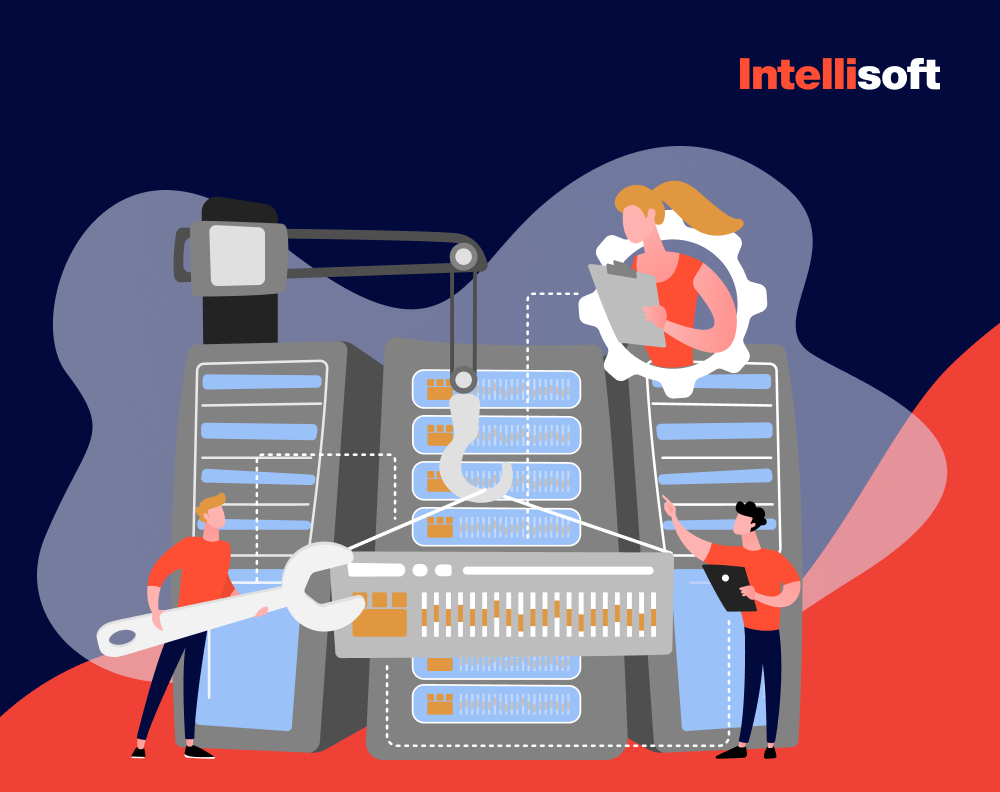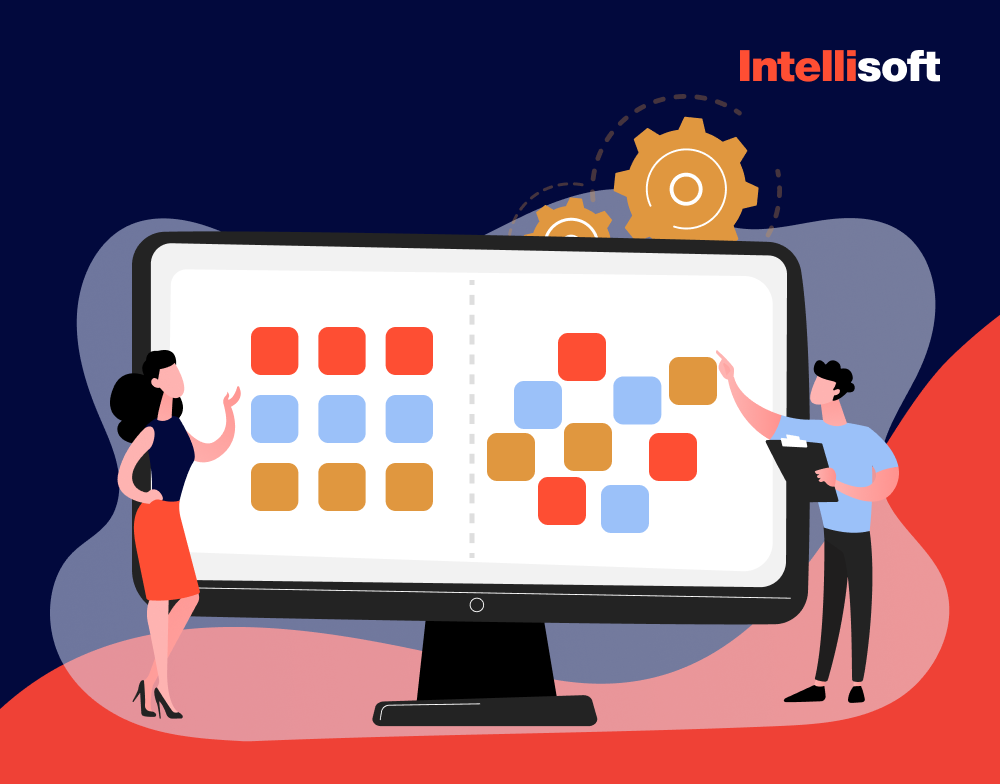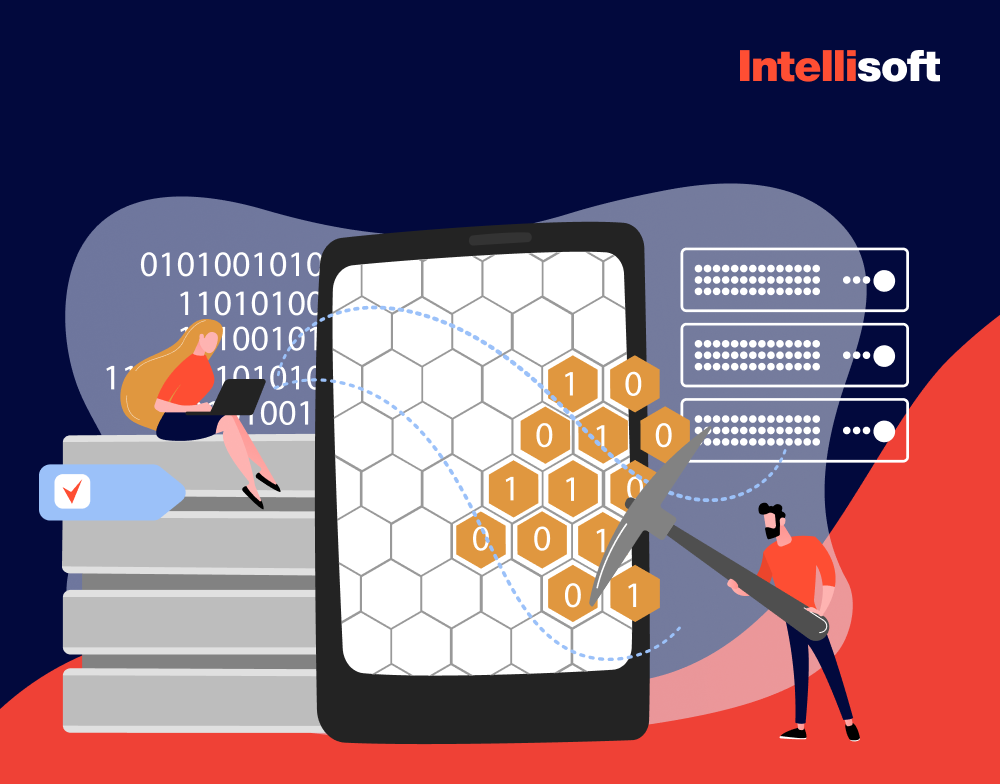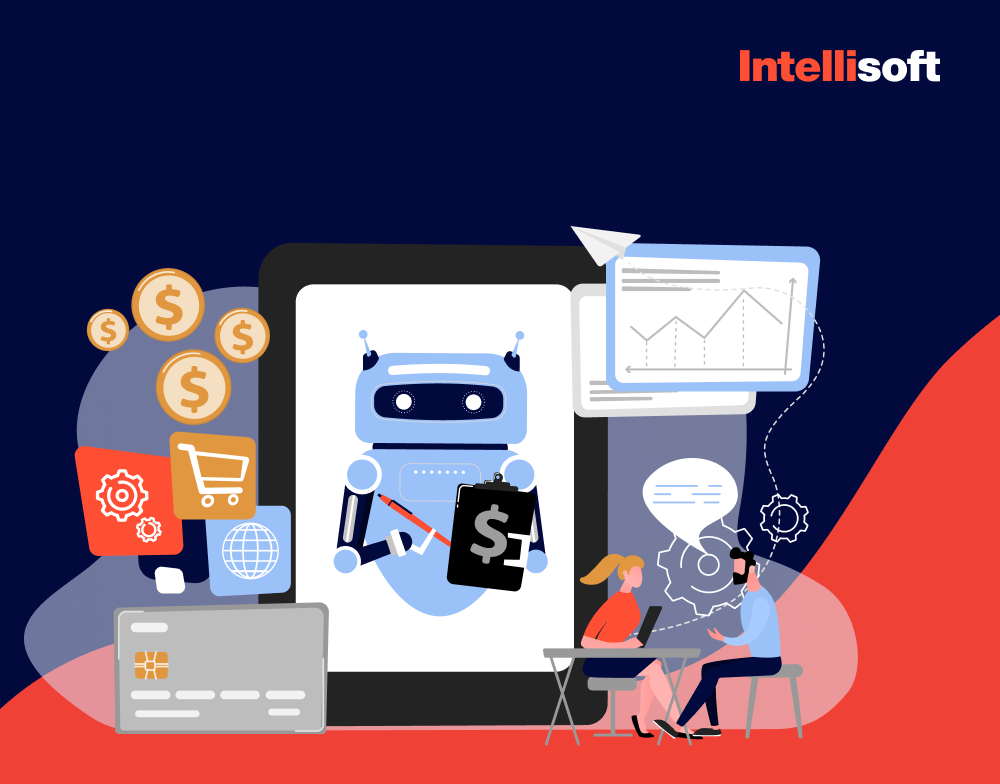Artificial intelligence (AI) has become a big disrupter in every industry. It brings a groundbreaking shift that’s reshaping how we do business. As AI becomes crucial in different sectors, we at IntelliSoft understand the pressing need for companies to embrace and integrate AI technologies. This move is now a proven way of improving their operations and how they serve their customers.
The AI market is rapidly growing. It reached the 200 billion U.S. dollar milestone in 2023 and is expected to climb to over 1.8 trillion U.S. dollars by 2030. Such remarkable growth is a tremendous opportunity for businesses to evolve and innovate. At IntelliSoft, we’re leading the charge in this tech revolution, offering our top-tier expertise in developing AI applications.
We know how to build an AI app and aim to guide businesses through this evolving field, equipping them with state-of-the-art AI tools that enhance growth and efficiency and give them a competitive edge. Let’s explore the key elements of AI in mobile app development together, lighting the way for your company’s technological advancement and transformation.
Table of Contents
The Compelling Case for Investing in AI Technology
We’re at a point where technology isn’t just part of the business landscape – it’s what leads it. Artificial intelligence (AI) is no longer an exciting option for tech startups and established companies in software development – it’s essential for every industry. Let’s discuss three key reasons why stepping into AI software development is a smart, strategic move that could elevate your business in the digital world.
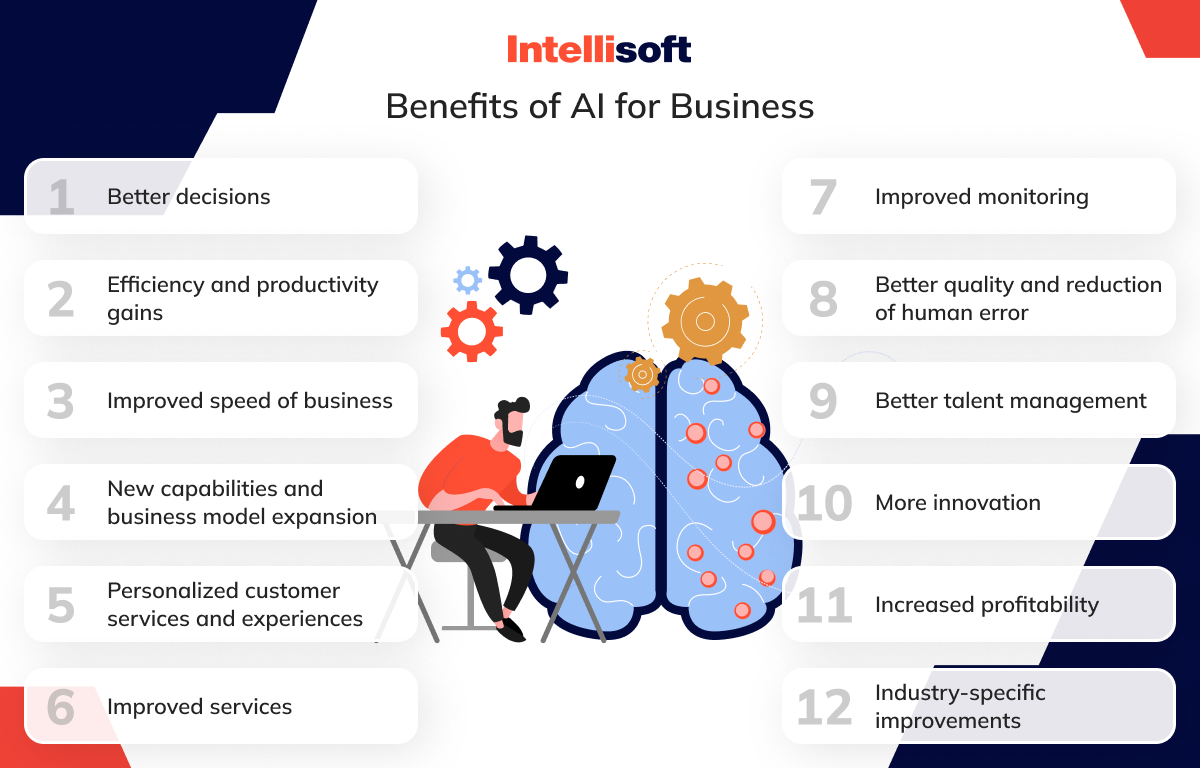
First off, AI opens the door to creating solutions that genuinely stand out, offering immense value to users. In a world full of standard offerings, AI-enabled applications make a mark by providing experiences that are personal, efficient, and smart. They’re capable of adapting services to individual needs, understanding what customers want on a deeper level, and even anticipating their future requirements. This kind of innovation leads to users who aren’t just satisfied but loyal.
Then, there’s the competitive edge AI gives you. Today’s business environment moves incredibly fast, and keeping up, let alone getting ahead, requires leveraging AI. Its ability to speed up innovation, automate processes, and make operations more efficient means you can move quickly, adapt to changes seamlessly, and stay a step ahead of the competition.
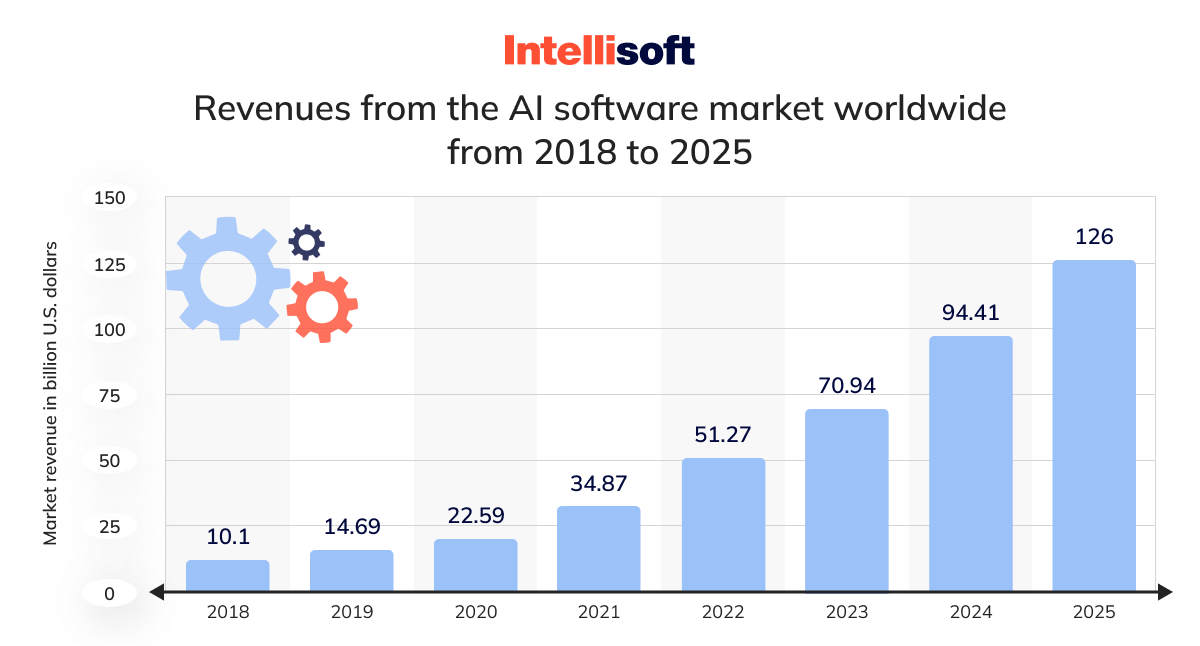
And we can’t overlook the economic argument for integrating AI into your strategy. Accenture research suggests that AI could double the economic growth rates for developed economies by 2035, and with the global rise of the AI software market, the financial benefits of investing in AI are clear. Beyond just improving operations, AI’s power to process huge amounts of data can lead to faster decisions, opening up new possibilities for enhancing customer service, predicting market trends, and even discovering new revenue opportunities.
Investing in AI software goes beyond just adopting new tech: It’s a strategic choice that brings real value, sharpens your competitive edge, and promises significant economic rewards. The message is loud and clear for any business, from startups to well-established names: the future favors those who innovate with AI.
The Building Blocks of Artificial Intelligence
If the concept of artificial intelligence still feels puzzling to you, you’re not alone. The complex AI puzzle includes several vital pieces, each of which plays a vital role in enabling machines to mirror the way we think and learn. If you want to learn how to build an AI app and leverage this technology in your line of work, you’d better understand these fundamental elements. Let’s shed some light on the inner workings that power the remarkable feats of AI.
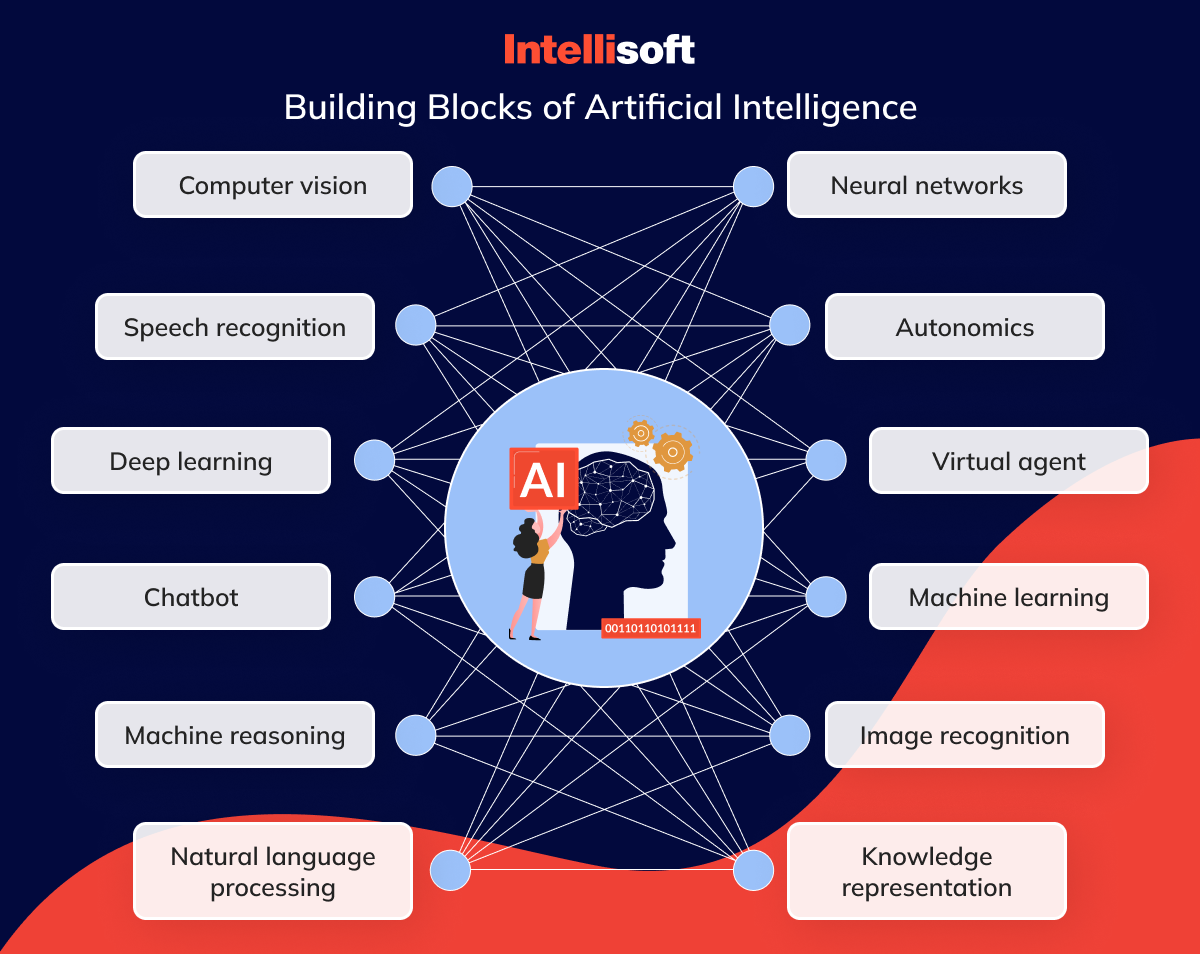
At the core of AI’s dynamic nature is Learning. It’s not just about storing data – it involves the system’s ability to fine-tune its operations with every new piece of information or experience, much like how we learn from our past. This adaptability is what boosts AI’s efficiency, allowing it to tackle increasingly complex tasks over time.
Reasoning is what enables AI to process its accumulated knowledge logically, drawing insights or making decisions. It’s as if AI is piecing together a puzzle, navigating through complex situations to offer solutions that weren’t directly inputted into its system.
When it comes to problem-solving, AI showcases its ability to sift through large masses of data, recognize patterns, and devise strategies to address challenges head-on. This process mirrors the analytical prowess of the human mind, showcasing AI’s ability to approach problems from various angles.
Perception grants AI the ability to sense its environment, much like our own sensory experiences. Through seeing, hearing, and other inputs, AI systems can gather data and make sense of the world around them, forming the basis for meaningful interactions.
Natural Language Processing (NLP) acts as the bridge for communication between humans and machines, allowing AI to understand and generate human language. It’s essential for creating systems that can have real conversations, understand inquiries, and offer natural and intuitive responses.
With Computer Vision, AI gains the capability to interpret visual data, effectively giving it eyes to see the world. This ability is pivotal for tasks that involve recognizing images, detecting objects, or navigating space, enabling machines to understand visual information with impressive accuracy.
Expert Systems replicate the decision-making prowess of human specialists, utilizing a vast store of knowledge and if-then rules to solve complex problems or provide expert advice, mimicking the insight typically drawn from human expertise.
These components collectively form the foundation of AI, equipping systems with the ability to learn, reason, solve problems, perceive, communicate, and see. They pave the way for developing intelligent applications that can think, learn, and engage with the world in a manner that closely resembles human intelligence.
How Does AI Work?
Diving into the world of artificial intelligence reveals the genius behind software that can think and act like us, from recognizing speech to making complex decisions. Peering into AI’s inner workings shows us a captivating process that starts with raw data and ends with intelligent actions. This process both mirrors and surpasses what we humans can do.
Deep learning stands out in AI, especially with its web of neural networks. It learns from unstructured data, enabling tasks such as translating languages or recognizing images. For instance, language models like ChatGPT use deep learning to understand and generate text, so naturally, it almost seems human.
Pioneering AI Applications Transforming the Business Landscape
AI is no longer science fiction. It moved into the core of business operations today. It has revolutionized industries with improved efficiency, personalization, and smart decision-making. Let’s talk about how some leading companies use AI to boost operations, reshape customer interactions, and stand out in the market.
Amazon is a prime example of AI innovation, using it to customize shopping experiences, streamline its enormous logistics operations, and power Alexa, its virtual assistant. This broad application of AI boosts both customer satisfaction and operational efficiency.
Netflix, known for its streaming services, uses AI to tailor viewing recommendations based on user preferences and habits. This personalized approach keeps viewers engaged and elevates their overall experience.
Facebook utilizes AI and deep learning to handle the vast amount of data it processes daily. AI helps organize data, moderate content, refine targeted advertising, improve the user experience, and maintain the platform’s integrity.
Apple incorporates AI across its products, enhancing user interaction with features such as Siri’s voice commands, facial recognition for security, and predictive text messaging. These technologies are indispensable to many.
Adobe is transforming the creative industry with AI-powered tools that simplify and enhance the creative process. Automatic image tagging and smart editing tools allow creatives to save time and explore new possibilities in digital art.
Uber applies AI to enhance its ride-sharing service, optimizing driver-passenger matching, route planning, and fare estimation. This intelligent system ensures efficiency and satisfaction, setting new standards in mobility services.
Salesforce uses AI to revolutionize customer relationship management, predicting customer behavior, automating tasks, and personalizing interactions. These AI-driven capabilities enable businesses to develop deeper, more meaningful customer relationships.
These examples highlight AI’s game-changing role in business, showing its essential contribution to competitiveness in the digital age. As AI evolves, it opens up even more innovative ways for companies to operate, engage with customers, and grow.
Related readings:
- The Top 10 Programming Languages Powering AI and Machine Learning
- Supply Chain Data Analytics for Efficient Operations
- How Predictive Analytics Solutions Are Benefitting Supply Chain
- Predictive Analytics in Retail: Boosting ROI and Transforming Customer Experience
- Product Roadmap Guide: Recommendations & Hints
How to Build an Artificial Intelligence App: Step-by-Step
Building an AI application might feel like you’re stepping into a maze of technical challenges. Yet, by partnering with a reliable AI development company, like IntelliSoft, and breaking it down into smaller, manageable steps, the path from an idea to a fully functioning app becomes clearer. Let’s walk through all the stages of crafting an AI app.
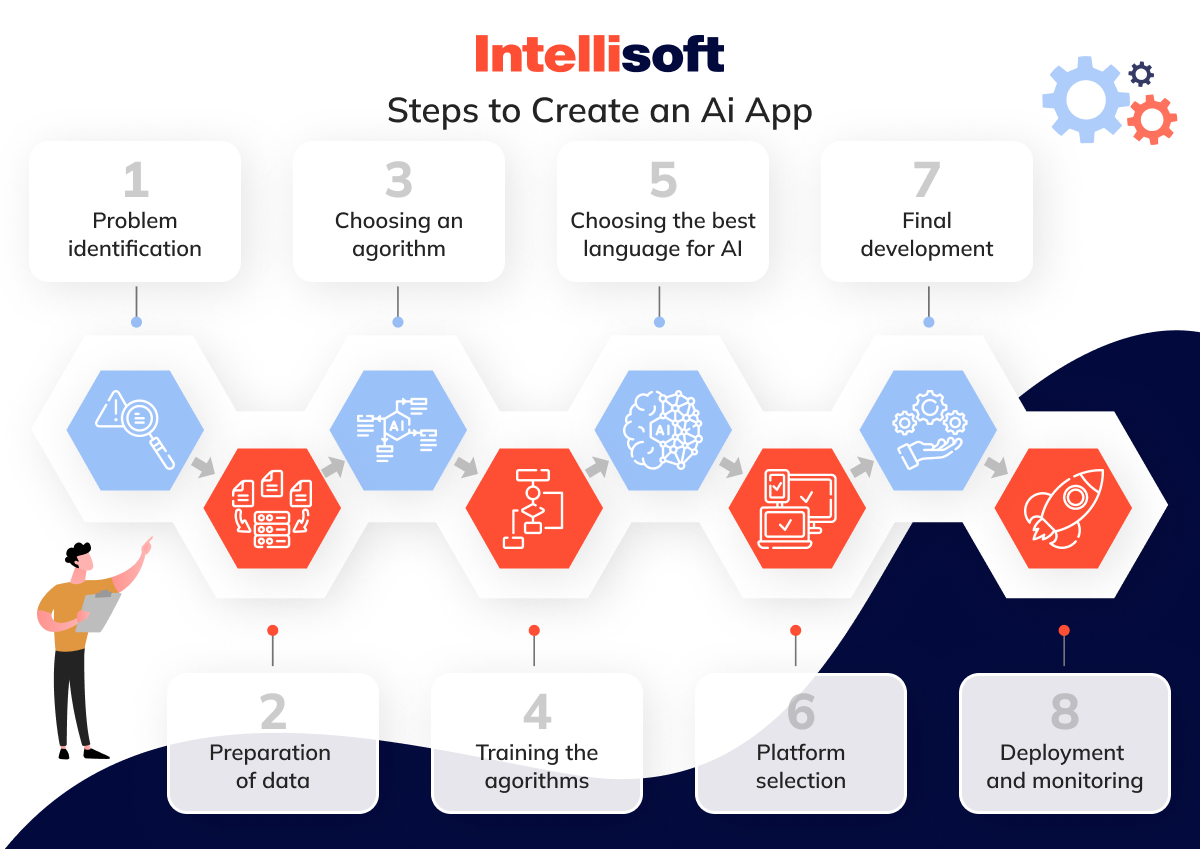
Step 1. Figuring Out the Problem
The very first step in creating an AI application is to define the issue you’re tackling clearly. This stage isn’t just about the tech side of things – it’s about understanding how your app will make a difference for its users.
Whether you’re aiming to make business processes smoother, boost customer satisfaction, or uncover insights from data, you need to identify a precise problem where AI can be a game-changer. This clear goal will steer the entire development process, ensuring every tech decision directly contributes to solving the problem efficiently.
Step 2. Getting Your Data Ready
The heart of any AI application is data. The success of your app greatly relies on the quality, volume, and relevance of the data you use. Preparing this data involves collecting, cleaning, labeling, and sometimes even enhancing it to make sure it’s in tip-top shape for your AI to learn from.
Often, this step requires a dedicated team to meticulously organize and annotate the data, laying a solid foundation for the AI’s learning phase. The effort put into preparing your data can significantly impact the effectiveness of your AI model.
Step 3. Picking the Right Algorithm
Choosing the correct algorithm is crucial in AI mobile app development. This decision depends on the problem you’re addressing and the kind of data you have. Algorithms fall into categories like supervised or unsupervised learning, each fitting different scenarios.
For example, supervised learning is great for tasks with clear expected outcomes, while unsupervised learning is better for identifying patterns without explicit guidance. Selecting an algorithm involves evaluating which one best aligns with your app’s objectives and ensuring it can process your data to deliver valuable insights or actions.
Step 4. Teaching the Algorithms
With the right algorithm in hand, it’s time to train it using your data. This stage is a blend of precision and experimentation as you adjust the algorithm’s settings to improve its prediction or classification ability.
Training is iterative, meaning you’ll likely undergo several tweaks and tests to refine the algorithm’s performance. The aim is to craft a model that not only grasps the training data but can also apply what it has learned to new, unseen data effectively.
Step 5. Choosing the Best Language for AI
Moving from the drawing board into the actual making of an AI application requires ideas and the right tech tools, starting with picking a programming language. This choice is far from minor – it’s central to the app’s ability to crunch data, learn from it, and engage users. Each language has its strengths, like Python’s user-friendliness and rich libraries for machine learning, Java’s platform independence and reliability, and C++’s speed.
Matching the language to the app’s specific needs, whether that’s for processing natural language, handling complex datasets, or crafting learning algorithms, is crucial. Python often stands out in AI development for its simplicity and vast resources for machine learning and deep learning.
Step 6. Selecting the Platform
After settling on a language, choosing the right platform to build and roll out your AI app is your next big move. The market offers rich frameworks and APIs that come packed with features for deep learning, neural networks, and natural language processing. Cloud services from tech giants like Google’s TensorFlow, Microsoft Azure, and Amazon Machine Learning provide a treasure trove of tools and services, making it easier to add sophisticated AI functionalities.
Deciding on a platform involves weighing factors such as cloud services, data storage locations, API offerings, and costs, which together influence the app’s design, scalability, performance, and feature set.
Step 7. Developing the App
With all the prep and tech decisions out of the way, it’s time to dive into actual development. This phase follows traditional software development steps – designing the architecture, crafting the user interface, and knitting together front and back ends.
What sets it apart is the integration of AI-specific models and workflows, often adopting the CRISP-DM process for a structured approach. Optimizing for performance, scalability, and future growth is key, ensuring the app meets current demands and is ready to evolve with new AI advancements and market changes.
Step 8. Testing, Deployment, and Monitoring
Reaching the end of development marks a new beginning – testing, launching, and ongoing upkeep. Thorough testing checks off all functionality, performance, and user experience requirements. After successful tests, the app is launched, but the job isn’t done. AI mobile apps need constant monitoring and maintenance to stay relevant.
You need to update data to avoid model decay and ensure the app keeps up with new data trends while staying secure through software updates. Regular checks and updates are vital to keep the app performing well, secure, and valuable to users.
Each step of the AI development journey is vital and requires detailed attention to ensure the final product is technologically sound and truly meets user needs and business objectives.
Tech Stack for AI Application Development
Creating AI applications is no small feat. It requires a diverse set of technological tools at every step, from handling initial data to rolling out the final product. Here’s a walkthrough of the essential tech stack for AI development.
Programming Languages
The process begins with selecting the right programming languages. Python is a favorite for its straightforward syntax and extensive libraries designed for AI and machine learning, making it the top pick for many developers. R is also valued, particularly for statistical analysis and data visualization, and is often used in research and academia.
Machine Learning Libraries and Frameworks
At the core of AI development are libraries and frameworks such as TensorFlow and PyTorch. TensorFlow, developed by Google, excels in crafting and deploying intricate neural networks, while PyTorch offers a user-friendly interface for fast prototyping, making it a hit among researchers. Scikit-learn and Keras round out the toolkit with a wide range of data analysis algorithms and a high-level API for neural networks, respectively.
Third-Party APIs
Incorporating third-party APIs and software development kits (SDKs) can further expedite the development journey. For instance, the Azure Text Analytics API excels in natural language processing, while the Azure AI Vision is great for facial recognition tasks. Google Vision API and Apple SiriKit, respectively, offer advanced capabilities for image analysis and voice interaction, providing developers with ready-to-use solutions for enriching applications with sophisticated AI features.
Data Processing and Analysis Tools
Handling and understanding data is crucial. Python libraries such as Pandas and NumPy are fundamental for data manipulation, providing powerful tools for numerical data management. For visualizing data, Matplotlib and Seaborn allow developers to generate interactive and insightful charts, shedding light on data patterns.
Development Environments
A conducive development environment is key. Jupyter Notebook offers an interactive setup perfect for data exploration, while IDEs such as PyCharm and Visual Studio Code enhance Python development with their robust features, improving code efficiency and teamwork.
Data Storage and Management
Proper data storage solutions are vital for managing AI projects’ extensive data volumes. SQL databases handle structured data storage, whereas NoSQL databases are better for unstructured or semi-structured data. Data lakes such as AWS S3 or Google Cloud Storage are indispensable for storing large quantities of raw data.
Deployment and Hosting
Technologies such as Docker and Kubernetes provide containerization and orchestration capabilities for deployment and management. Cloud platforms such as AWS, Google Cloud Platform, and Azure deliver the necessary infrastructure for efficient AI application deployment and scaling.
Monitoring and Logging
Monitoring tools such as TensorBoard give insights into TensorFlow models, while the ELK Stack offers extensive logging and monitoring features. Prometheus and Grafana are essential for tracking and visualizing time-series data to keep the app running smoothly.
Version Control and CI/CD
Git is fundamental for version control and tracking code changes efficiently. Collaboration platforms like GitHub, GitLab, and Bitbucket, along with CI/CD tools such as Jenkins and GitHub Actions, ensure smooth and consistent app deployment processes.
Security
Lastly, security is paramount. SSL/TLS protocols, OAuth for authorization, and measures like firewalls and Network Security Groups are crucial for protecting AI applications and their data.
This tech stack forms the backbone of AI application development. It equips developers with the necessary tools and technologies to navigate the complexities of AI projects.
How Much Does It Take to Build an AI Mobile App
Developing an AI application raises a key question: How much will it cost? The answer is far from straightforward, influenced by several critical factors that make the financial landscape quite variable.
Scope and Complexity Matter
The ambitions behind your AI project are major cost determinants. The budget might be on the lower end for basic AI features like chatbots or recommendation engines. However, introducing more complex capabilities such as advanced machine learning, natural language processing, or computer vision inflates the investment needed. Projects requiring intricate data analysis and prediction models call for hefty development work, thus inflating costs.
Data Drives the Budget
Data is the lifeblood of AI applications. The volume, variety, quality, and complexity of the data needed directly influence the expenses. Gathering, cleaning, and making this data model-ready is a specialized task. The quest for unique, high-quality datasets can further increase costs, especially if acquiring or preprocessing data becomes necessary.
The Right Team Comes at a Price
The expertise of your development team is pivotal. Experienced developers with a deep understanding of machine learning have higher rates, which can vary greatly based on their background, location, and demand for their skills. Though costlier, their expertise in tackling AI’s complexities can lead to a more sophisticated, scalable, and innovative application.
Given these factors, AI app development costs can swing from relatively modest for simple applications to significant sums for large-scale, complex systems. Estimates might range from around $6,000 for straightforward projects to upwards of $500,000 for tailored, advanced solutions.
Consulting with experienced developers and data scientists early on can shed light on achieving AI features cost-effectively, ensuring your investment results in a robust and innovative solution that aligns with your business needs.
Conclusion
We witness the advancement of AI every day. The development of an AI application has immense potential to reshape your business. At its heart, deep learning enables AI to perform tasks with human-like intelligence. AI quickly becomes a key player in driving business innovation and success. It enhances customer experiences and operational efficiency, so industries, from fintech to social media and telemedicine, embrace it.
AI’s versatility shines in various domains. It makes operations smoother and leads to innovative services and products. Businesses can strategically use AI to discover new markets, refine processes, and offer unmatched customer value. Yet, developing AI apps is challenging. It requires deep knowledge of AI, machine learning, and data science. Plus, there’s the task of managing data, choosing algorithms, and integrating systems.
This is where the importance of partnering with an experienced AI development company becomes clear. IntelliSoft stands out here. Our AI and machine learning development history makes us the ideal partner for your project. Our expert team combines industry experience with technical know-how. We deliver AI solutions that fit your business goals perfectly.
Start your AI journey with IntelliSoft. Let us help you turn your innovative ideas into reality. Contact us to get a rough estimate for your AI mobile app development project. With our support, your business will stay ahead in technological advancement and market leadership.
